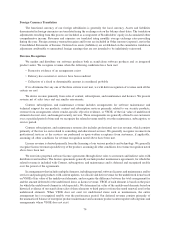Symantec 2007 Annual Report Download - page 85
Download and view the complete annual report
Please find page 85 of the 2007 Symantec annual report below. You can navigate through the pages in the report by either clicking on the pages listed below, or by using the keyword search tool below to find specific information within the annual report.Prior to the adoption of SFAS No. 123R, we presented all tax benefits for deductions related to stock options as
operating cash flows in our Consolidated Statements of Cash Flows. SFAS No. 123R requires cash flows resulting
from the tax benefits for tax deductions in excess of the compensation expense recorded for exercised options to be
classified as financing cash flows. Accordingly, we classified $26 million of such excess tax benefits as financing
cash flows rather than operating cash flows in our Consolidated Statement of Cash Flows for the fiscal year ended
March 31, 2007.
Pursuant to the income tax guidance included in SFAS No. 123R, we have elected the regular method of
computing the pool of excess tax benefits, or APIC pool.
Concentrations of Credit Risk
A significant portion of our revenues and net income is derived from international sales and independent
agents and distributors. Fluctuations of the U.S. dollar against foreign currencies, changes in local regulatory or
economic conditions, piracy, or nonperformance by independent agents or distributors could adversely affect
operating results.
Financial instruments that potentially subject us to concentrations of credit risk consist principally of cash and
cash equivalents, short-term investments, trade accounts receivable, and forward foreign exchange contracts. Our
investment portfolio is diversified and consists of investment grade securities. Our investment policy limits the
amount of credit risk exposure to any one issuer and in any one country. We are exposed to credit risks in the event of
default by the issuers to the extent of the amount recorded in the Consolidated Balance Sheets. The credit risk in our
trade accounts receivable is substantially mitigated by our credit evaluation process, reasonably short collection
terms, and the geographical dispersion of sales transactions. We maintain reserves for potential credit losses and
such losses have been within management’s expectations.
Legal Expenses
Prior to October 1, 2006, we recognized a liability for cases where we are the defendant for estimated external
legal costs to be incurred during the next fiscal quarter. Effective October 1, 2006, we changed our policy related to
legal costs from one generally accepted method of accounting to another generally accepted method of accounting.
Under our new policy, we will no longer recognize a liability for external legal costs related to future periods.
Instead, we will expense such amounts in the period incurred. We believe that this new policy is preferable in the
circumstances because the costs and administrative burden involved in estimating future legal expenses outweigh
the benefits. Further, we believe that this new method more accurately aligns the expense with the accounting period
in which it is incurred. We will continue to accrue amounts related to external legal costs that are incurred during the
period and to accrue probable losses in the period in which the loss is identified. The impact of this change in
accounting method is inconsequential for all prior periods presented, and, therefore, prior periods have not been
revised to reflect this change.
Accumulated Other Comprehensive Income
We report comprehensive income or loss in accordance with the provisions of SFAS No. 130, Reporting
Comprehensive Income, which establishes standards for reporting comprehensive income and its components in the
financial statements. The components of other comprehensive income consist of unrealized gains and losses on
available-for-sale securities, net of tax, and foreign currency translation adjustments, net of tax. Unrealized losses
on our available-for-sale securities were $2 million and $6 million as of March 31, 2007 and 2006 respectively.
Comprehensive income is presented in the accompanying Consolidated Statements of Stockholders’ Equity and
Comprehensive Income.
79
























